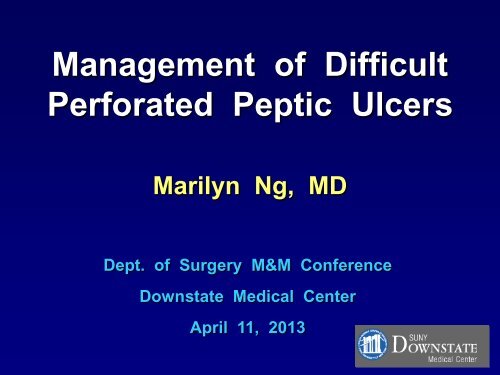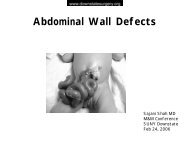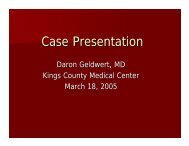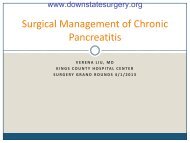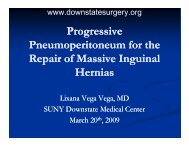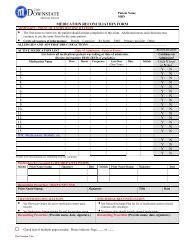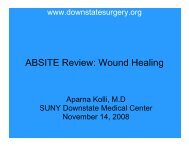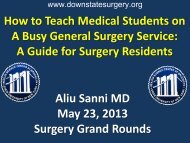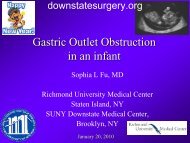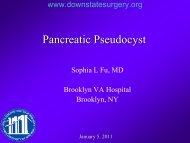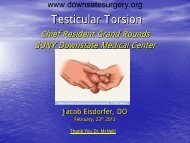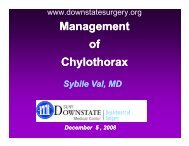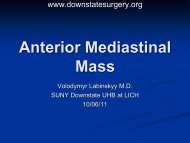COMPONENT SEPARATION - Department of Surgery at SUNY ...
COMPONENT SEPARATION - Department of Surgery at SUNY ...
COMPONENT SEPARATION - Department of Surgery at SUNY ...
You also want an ePaper? Increase the reach of your titles
YUMPU automatically turns print PDFs into web optimized ePapers that Google loves.
Management <strong>of</strong> Difficult<br />
Perfor<strong>at</strong>ed Peptic Ulcers<br />
Marilyn Ng, MD<br />
Dept. <strong>of</strong> <strong>Surgery</strong> M&M Conference<br />
Downst<strong>at</strong>e Medical Center<br />
April 11, 2013
Case Present<strong>at</strong>ion<br />
‣ 58 yo F with PMHx <strong>of</strong> HTN<br />
‣ SHx: C – section & SocHx: neg<strong>at</strong>ive<br />
‣ 9-mo hx abd distention & pain<br />
‣ Non - bilious emesis several days<br />
‣ BIBEMS for altered mental st<strong>at</strong>us
ED Physical Exam<br />
‣ BP 221/123 HR 110 RR 25 S<strong>at</strong> 99% RA<br />
‣ Gen: AAO x 2<br />
‣ Abd: s<strong>of</strong>t, abd distention, diffuse<br />
tenderness, lower midline scar
ED Lab Results<br />
‣ CBC: 7.6 > 15.1 / 43.6 < 293 N 80%<br />
‣ BMP: 141 / 3.2 / 92 / 34 / 0.16 < 120<br />
‣ Coag: normal<br />
‣ VBG: 7.48 / 30 / 44 / 32 / 58% / +8
A Long Prelude to the OR<br />
‣ HD#1: Admitted for GOO<br />
‣ IVF resuscit<strong>at</strong>ion<br />
‣ PPI drip & broad-spectrum abx<br />
‣ Refused NGT & central line placement<br />
‣ HD#2: Tachycardic, normal BP,<br />
worsening abd pain & WBC 13.9
Three Days L<strong>at</strong>er . . .<br />
‣ HD#3: Tachycardia, 7 L IVF<br />
‣ Portable CXR: no free air<br />
‣ Bandemia 58%, Cr 2.3, Lact<strong>at</strong>e 2.3<br />
‣ ABG: 7.37/28/100/16/17/97%/-7.7<br />
‣ Repe<strong>at</strong> CT abd/pelvis
Explor<strong>at</strong>ory Laparotomy<br />
‣ Drainage 3 L gastric fluid<br />
‣ Perfor<strong>at</strong>ed giant pre-pyloric ulcer (4 cm)<br />
‣ Distal gastrectomy, truncal vagotomy,<br />
gastrojejunostomy, tube duodenostomy,<br />
repair <strong>of</strong> esophageal injury, wide<br />
drainage
Post – Oper<strong>at</strong>ive Course<br />
‣ POD#0: ICU; intub<strong>at</strong>ed, IVF, PPI, Abx<br />
‣ POD#3: Extub<strong>at</strong>ed<br />
‣ POD#4: Normalized Cr; ICU transfer<br />
‣ POD#11: Gastrografin swallow neg<strong>at</strong>ive<br />
for leak or stricture clear liquids
Post – Oper<strong>at</strong>ive Course<br />
‣ POD#12: Full liquids; Blake drain D/C’ed<br />
‣ POD#15: Duodenostomy tube clamped<br />
‣ POD#16: JP drains removed<br />
‣ POD#19: Post – gastrectomy diet<br />
‣ POD#24: Discharged home
P<strong>at</strong>hology<br />
‣ Both vagus nerves transected<br />
‣ Neg<strong>at</strong>ive for malignancy<br />
‣ Chronic gastric mucosal inflamm<strong>at</strong>ion<br />
‣ H. pylori neg<strong>at</strong>ive
Management <strong>of</strong> Difficult<br />
Perfor<strong>at</strong>ed Peptic Ulcers<br />
‣ Epidemiology<br />
‣ Etiology<br />
‣ Immedi<strong>at</strong>e Concerns<br />
‣ Oper<strong>at</strong>ive Principles<br />
‣ Difficult Perfor<strong>at</strong>ed<br />
Peptic Ulcers (PPU)
Epidemiology<br />
‣ 300,000 new PUD cases per year<br />
‣ 2% U.S. prevalence<br />
‣ 10% lifetime cumul<strong>at</strong>ive prevalence<br />
‣ 50% world popul<strong>at</strong>ion has H. pylori<br />
‣ Only 10-15% will develop PUD
Etiology<br />
‣ Focal mucosal defects th<strong>at</strong> extend into<br />
submucosa or deeper<br />
‣ H. pylori in 70-90% DU & 30-60% GU
Complic<strong>at</strong>ion: Perfor<strong>at</strong>ion<br />
‣ Acute perfor<strong>at</strong>ions in 2 -<br />
10% <strong>of</strong> PUD<br />
‣ <strong>Surgery</strong> almost always<br />
indic<strong>at</strong>ed<br />
‣ 6 - 30% risk <strong>of</strong> mortality<br />
‣ Conserv<strong>at</strong>ive tre<strong>at</strong>ment<br />
with contained<br />
perfor<strong>at</strong>ion Lee and Sarosi. Surg Clin N Am, 2011
Immedi<strong>at</strong>e Concern: Sepsis<br />
‣ Large bore IV<br />
‣ IV fluid resuscit<strong>at</strong>ion<br />
‣ Broad - spectrum<br />
antibiotics & PPI<br />
‣ Invasive monitoring<br />
‣ Monitor urine output
Clincal Stages <strong>of</strong> PPU<br />
Stage<br />
First<br />
< 2 hrs<br />
Second<br />
2-12 hrs<br />
Third<br />
> 12 hrs<br />
Present<strong>at</strong>ion<br />
Abrupt onset abd pain, epigastric<br />
generalized<br />
Rigidity, RLQ tenderness from<br />
drainage <strong>of</strong> succus<br />
Abd distention, fever,<br />
hypovolemia, abdominal distention<br />
Lee and Sarosi. Surg Clin N Am, 2011
Oper<strong>at</strong>ive Principle<br />
Do only wh<strong>at</strong><br />
is necessary<br />
in an unstable<br />
pt in an<br />
emergency
Graham, Graham, Graham
Modified Johnson Classific<strong>at</strong>ion<br />
Billroth I<br />
Billroth II
Type IV PPU<br />
Newman NA, et al. Cameron’s Current Surgical Therapy, 10 th Ed.
Types <strong>of</strong> Vagotomy
PPI Shifting the Paradigm<br />
‣ 1980s: elective PU<br />
cases dropped >70%<br />
‣ 80% <strong>of</strong> cases were<br />
emergent surgeries<br />
Newman NA, et al. Cameron’s Current Surgical Therapy, 10 th Ed.
Difficult PPU: Wh<strong>at</strong> to Do?
Graham P<strong>at</strong>ch, Anyone ?
Thal Serosal P<strong>at</strong>ch<br />
Sorour M et al. Egyptian J Surg, 2012
Pyloric Exclusion
Pyloroplasty<br />
‣ Full-thickness<br />
incision 2 cm<br />
proximal & distal to<br />
pyloric ring<br />
‣ Incision closed<br />
vertically
Jaboulay Pyloroplasty<br />
‣ Parallel incisions<br />
‣ Drainage<br />
bypassing the<br />
pyloric channel<br />
ulcer
Finney Pyloroplasty<br />
‣ Inverted U-shaped<br />
incision<br />
‣ Indic<strong>at</strong>ed for<br />
“scarred down”<br />
duodenum
Nissen’s Procedure<br />
‣ Posterior DU<br />
perfor<strong>at</strong>ion<br />
‣ Scar tissue<br />
‣ Chronic<br />
inflamm<strong>at</strong>ion<br />
Maher JW and Chikunguwo SM. Fischer’s Mastery <strong>of</strong> <strong>Surgery</strong>, 2012
Tube Duodenstomy<br />
Lee and Sarosi. Surg Clin N Am, 2011
Summary<br />
‣ Up to 10% PUD perfor<strong>at</strong>e<br />
‣ Do ONLY wh<strong>at</strong> is necessary to manage<br />
‣ Often Graham p<strong>at</strong>ch repair<br />
‣ Giant ulcers may require Thal p<strong>at</strong>ch<br />
‣ Pyloric exclusion & drainage procedure<br />
‣ Tube duodenostomy for the difficult<br />
duodenum
Which type <strong>of</strong> gastric ulcer corresponds<br />
with the correct an<strong>at</strong>omic loc<strong>at</strong>ion:<br />
A. Type I – prepyloric region<br />
B. Type II – lesser curv<strong>at</strong>ure <strong>of</strong> the<br />
stomach near the GE junction<br />
C. Type III – body <strong>of</strong> the stomach along<br />
the lesser curv<strong>at</strong>ure<br />
D. Type IV – lesser curv<strong>at</strong>ure <strong>of</strong> the<br />
stomach near the GE junction<br />
E. Type IV – prepyloric region
A 75-yo man taking NSAIDS for arthritis has an<br />
acute abdomen and free air. His symptoms<br />
are 6 hrs old and his vital signs are stable<br />
after 1 L <strong>of</strong> NS. A perfor<strong>at</strong>ed duodenal ulcer<br />
is identified, which is the best required<br />
oper<strong>at</strong>ion:<br />
A. Suture closure <strong>of</strong> the perfor<strong>at</strong>ion<br />
B. Omental p<strong>at</strong>ch <strong>of</strong> the perfor<strong>at</strong>ion<br />
C. Repair <strong>of</strong> the perfor<strong>at</strong>ion and HSV<br />
D. Repair <strong>of</strong> the perfor<strong>at</strong>ion and truncal<br />
vagotomy<br />
E. Repair <strong>of</strong> the perfor<strong>at</strong>ion and gastric<br />
resection
Which oper<strong>at</strong>ion for duodenal ulcer is<br />
least likely to produce undesirable<br />
postoper<strong>at</strong>ive symptoms :<br />
A. Subtotal gastrectomy<br />
B. Truncal vagotomy and pyloroplasty<br />
C. Truncal vagotomy and antrectomy<br />
D. Selective vagotomy<br />
E. Highly selective vagotomy
References<br />
‣ Dempsey DT. Chapter 26. Stomach. Schwartz's Principles <strong>of</strong> <strong>Surgery</strong>. 9th<br />
ed. New York: McGraw-Hill.<br />
‣ Lee CW and Sarosi Jr GA. Emergency ulcer surgery. Surg Clin N Am.<br />
2011; 91:1001-1013.<br />
‣ Hermansson M et al. Surgical approach and prognostic factors after peptic<br />
ulcer perfor<strong>at</strong>ion. Eur J Surg. 1999; 165: 566.<br />
‣ Sorour M et al. Study <strong>of</strong> the role <strong>of</strong> jejunal serosal p<strong>at</strong>ch in the<br />
management <strong>of</strong> large gastroduodenal perfor<strong>at</strong>ions. Egyptian J Surg. 2012;<br />
31(3): 116-122.<br />
‣ Mulholland MW and Simeone DM. Benign gastric disorders. Maingot’s<br />
Abdominal Oper<strong>at</strong>ions. 11 th ed. New York: McGraw-Hill.<br />
‣ Newman NA, et al. Benign gastric ulcer. Cameron’s Current Surgical<br />
Therapy. 10 th ed. Philadelphia: Elsevier.<br />
‣ Maher JW and Chikunguwo SM. Fischer’s Mastery <strong>of</strong> <strong>Surgery</strong> 6 th ed.<br />
Philadelphia: Lippincott


